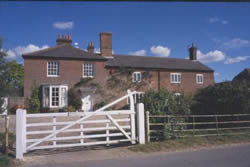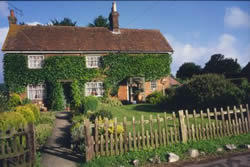
|
The Rectory
Grown Knee and Clay Tiles
The Reading Room
Topps Farm
Leaded Window
Virginia Cottage |
10. Character And Types Of Buildings The character of the area is established by the scattered cottages and agricultural buildings. A large number of the cottages are timber framed. Except for a small number with 14th and 15th century cruck frames (mostly hidden under 18th and 19th century brickwork) most are l6th, l7th and 18th century box framed construction, with wattle and daub or brick infill panels and leaded or cast iron window frames. Roofs are thatched or of clay tiles. Later buildings are mainly brick construction with clay tile or slate roofs. A number of these buildings have brick patterns which enhance their appearance. The barns, cart sheds and granaries are mainly 17th and 18th century buildings. The majority of these too are timber framed, some on brick plinths or staddle stones, clad with weatherboarding and with clay tiled roofs. These materials and methods of construction are fundamental to the character and the historic and architectural interest of the buildings. 11. Hedges, Walls and Fences Hedges are generally formed of traditional hedging plants reflecting those found in the field hedgerows. The height of the hedge has been established generally at about 1 metre. All trees in a conservation area have the same protection as those covered by tree preservation orders and it is an offence to fell or prune such trees without prior written consent. Fences are varied in style with no particular format dominant. Some older properties have brickwall boundaries and these vary in height between I and 2 metres. In three instances there are cob walls 2 metres high finished with a thatch or tile ridge. 12. Distinctive Village Features Distinctive features can be listed as follows: - Large number of thatched buildings (most thatched in long straw) many existing from the 16th century. Window frames having small panes of glass either in leaded lights or in Cast Iron frames. Roof shape - Layout and siting of buildings still clearly reflect the development of the village over five to six centuries. 13. Doors and Windows The doors and windows form a key element in the street scape. Wide doors, some with iron furniture, are set in masonry openings. Some are protected from the weather by simple corbelled canopies. There are a wide variety of sash and casement windows, some set in stone surrounds and cills. The mullions and transoms dividing the windows into small panes are sensitively detailed with elegant timber sections in later windows' whilst earlier 19th century windows were formed in this style in cast iron. Some of the older buildings still have their leaded lights. 14. Roofs Roofs vary from thatch through to clay tile and slate with the shape reflecting the pitch required for the particular finish. Many roofs have hipped ends. 15. Brickwork & Claddings Brickwork generally reflects the age of the building, the older buildings having locally produced bricks set in and pointed with lime mortar. Newer buildings have generally tried to match the colour and pointing (flush) with that of the older buildings. Many of the Victorian buildings have simple patterns incorporated in the brickwork. Some of the old timber frame buildings retain wattle and daub infill panels. The lime mortar finish to most of the panels has in the last century been replaced with a Cement/Sand mortar finish. Brick infill, which has replaced the wattle and daub, is generally straight course but in one or two instances there are herringbone pattern. |
| Statutary Documents |
| Public Land and Building Assets |
| List of Councillors |
| Minutes of Meetings |
| Council Policies & Documents |
| Agenda |
| Expenditure over £100 |
| BDC Key Dates 2021 |
| Current Notices |
| Minutes Archive |
| Landscape Character |
| Settlement Pattern Character |
| Buildings and Spaces |
| Highways and Traffic |
| Harnham Monitor |
| East Mills Flume |





